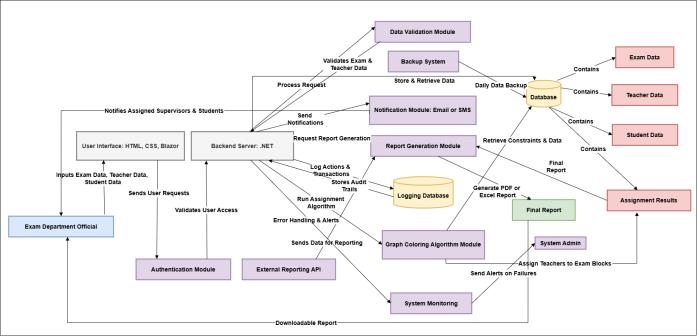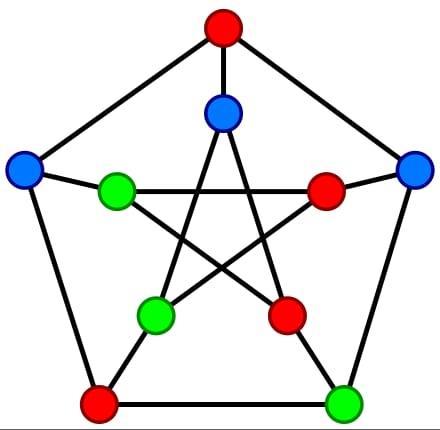
International Research Journal of Engineering and Technology (IRJET) e-ISSN:2395-0056
Volume: 12 Issue: 02 | Feb 2025 www.irjet.net p-ISSN:2395-0072


International Research Journal of Engineering and Technology (IRJET) e-ISSN:2395-0056
Volume: 12 Issue: 02 | Feb 2025 www.irjet.net p-ISSN:2395-0072
Dhanraj Deshpande1, Sameer Pagar2, Wafiyah Sayyad3, Advait Shukla4 , Yogesh Tupe5
1Assistant Professor, Department of Computer Engineering, Gokhale Education Society’s R. H. Sapat College of Engineering, Management Studies & Research, Nashik – 422005, Maharashtra, India 2,3,4,5Student, Department of Computer Engineering, Gokhale Education Society’s R. H. Sapat College of Engineering, Management Studies & Research, Nashik – 422005, Maharashtra, India
Abstract - Managing examinations in large institutions can be a challenging and time-consuming task. Supervisors must be assigned to ensure no conflicts, such as instructors overseeing students from their department. Manual methods are often inefficient and error-prone, requiring substantialadministrativeeffort.Toaddresstheseissues,we propose an Automated Seating Arrangement and SupervisionSystemforUniversityExaminations.Thissystem utilizes a graph coloring algorithm to automate the allocation of supervisors, ensuring no teacher supervises their branch students, and assigns students to their respective exam slots. By streamlining reporting and automating notifications, the system improves operational efficiency, reduces paperwork, lowers manual effort, enhances accuracy, and simplifies the process while minimizingpotentialconflicts.
Key Words: Seating Arrangement, Automated System, GraphColoring.
Efficient management of exam halls and seating arrangementsiscrucialforasmoothexaminationprocess in educational institutions. Manual methods for allocating seatsandassigningsupervisorsareoftentime-consuming and prone to errors. Automating these tasks has become essential to enhanceaccuracyandstreamline the process. Recent studies have explored various approaches and algorithms to develop systems that simplify and optimize exammanagement.
Pathari et al. developed a web-based system that generates comprehensive exam hall details, including class, exam time, date, and subject, enabling students to easilylocatetheirexaminationhalls.NandhuKishoreetal. introduced an AI-powered authentication and automated seating system incorporating classifiers and AES (Advanced Encryption System), significantly improving the efficiency of exam management. Similarly, Adetona et al. addressed seating arrangement challenges using transparent programming techniques with PHP and JavaScript, integrating a graph-based seating generation module. Their approach aimed to optimize seating
arrangementsandreducethepotentialforcheatingduring exams.
Anirbanexploredthecomplexitiesofexamseatallocation, emphasizing challenges arising from large student populations and diverse constraints related to subjects, rooms, and departments. To address these, three sequential algorithms were proposed to create an optimizedseatingplan.Inamdarandcolleaguespresented a model advocating for automation in seating allocation, considering factors like room layout and class size to maintain order during examinations. Similarly, Dhotre et al. developed an automated seating arrangement system to assign exam halls efficiently while managing supervisoryduties,reducingrelianceonmanualeffortand expeditingexampreparationprocesses.
Proposed Work In this paper, we propose The Automatic Seating Arrangement and Supervision System for University Exams integrating both these approaches by automatizing the process of allotting center-seating arrangement and invigilator allocation with a Graph coloring technique. It caters to problems such as teacherstudent relations and ineffective manual processes, ensuring that both students are allocated seats according totheirexams,whilesupervisorsfollowsuit.
Extensiveresearchhasbeenconductedonoptimizingseat allocation in examination halls, reflecting the importance of this process in ensuring fairness and efficiency. Pathari et al. developed an online system for exam hall seating, which allowed students to access their seating details, including locations and answer script information, ahead of time. This system also included real-time updates, reducing the administrative workload and ensuring smoothoperationsduringlarge-scaleexaminations.
Nandhu Kishore et al. proposed a model combining a classifier algorithm and AES for secure and efficient seat allocation. The AES ensured secure login and user authentication,whiletheclassifierfacilitatedaccurateseat assignment. This method enhanced both operational

International Research Journal of Engineering and Technology (IRJET) e-ISSN:2395-0056
Volume: 12 Issue: 02 | Feb 2025 www.irjet.net p-ISSN:2395-0072
efficiency and security, addressing common challenges in manualseatingprocesses.
Adetonaetal.tackledtheissueofcheating,particularlyvia observable seating arrangements, by employing a Harmony Search Algorithm (HSA). Their system, built using PHP and JavaScript, strategically assigned seats to prevent students from sitting near peers taking the same course.Thisweb-basedapproachimprovedexamintegrity and addressed challenges related to proximity-based collusion.
Anirban focused on automating seating arrangements for large student populations with complex requirements. By utilizingthreesequentialalgorithms,thesystemefficiently generated seating plans that adhered to spatial and scheduling constraints. This approach reduced unused space, improved time efficiency, and demonstrated the effectiveness of automation for large-scale examination setups.
The authors proposed an automated seating system that takesintoaccountfactorssuchasroomlayout,numberof students, and seating capacity to create a structured and organized examination environment. By utilizing parameters like class size, room orientation, and bench availability, the system ensures optimal space utilization and minimizes the preparation time required for large institutions.
Dhotre et al. introduced a two-module system comprising Student Seating Arrangement and Supervision Duties Allocation. This system automates the assignment of examination halls and invigilators, significantly reducing the manual effort involved in exam preparation. The solution is scalable and canbe adapted to meet the needs of various institutions, enhancing both efficiency and accuracyintheprocess.

The Automatic Seating Arrangement and Supervision System for University Exams aims to streamline the complex processes associated with exam management in academic institutions. It addresses challenges such as
scheduling conflicts, manual data entry errors, and the extensive administrative workload involved in organizing exams.
The system's architecture integrates several components: data input, validation, processing, storage, and report generation. These elements work together to provide a unified interface for exam officials and students. The user interface, designed with HTML, CSS, and Blazor, offers a simple and secure platform for entering exam schedules, teacheravailability,andstudentdetails,ensuringaccessis restrictedtoauthorizedusers.
The backend server, built on ASP.NET, functions as the system's core, facilitating communication between components, validating inputs, running assignment algorithms,andmanagingdatastorageandretrieval.
A key feature of the system is the Graph Coloring Algorithm Module, which optimizes supervisor assignments by modeling exam blocks and teacher allocations as graph vertices and edges. This ensures that no teacher supervises their students, minimizing conflicts andmaximizingefficiency.
All data, including exam schedules, teacher and student details, and supervisor assignments, is stored in a relationaldatabase(e.g.,MySQLorExcel-based),providing areliableandeasilyaccessiblerecordforfuturereference.
The system incorporates a Data Validation Module to ensure all input criteria are met and to prevent conflicts related to student assignments. Once the assignments are finalized, the Report Generation Module creates detailed reports on seating arrangements and supervisor allocations, available for download in PDF or Excel formats. Following report generation, the Notification Moduleautomaticallyinformsstudentsandsupervisorsof theirassignedexamroom,date,andtime.
To enhance reliability, a Monitoring and Error Handling Module alerts administrators to any system errors, allowing for prompt resolution. For added data security and integrity, the system supports optional external connections to backup systems and reporting APIs. Daily backups safeguard data, while the reporting API enables integrationwithexternalplatforms.
Thismodular,secure,andscalablearchitectureeffectively automates the allocation of exam supervisors and seating arrangements. It minimizes manual labor and human error, providing an organized and efficient examination processthatbenefitsallstakeholdersinvolved.
The development of the Automated Seating and Supervision System for University Exams follows a

International Research Journal of Engineering and Technology (IRJET) e-ISSN:2395-0056
Volume: 12 Issue: 02 | Feb 2025 www.irjet.net p-ISSN:2395-0072
structured methodology that includes requirements analysis, system design, algorithm implementation, and comprehensive testing. This process aims to address the issuesrelatedtomanualscheduling,supervisorallocation, andseatingarrangementsineducationalinstitutions.
DuringtheRequirementsAnalysisphase,inputisgathered from key stakeholders, such as exam department officials and IT staff, to determine the system's essential features. These include automated supervisor assignments, secure data handling, real-time report generation, and notifications for both students and supervisors. Constraints are identified, including the requirement that teachers cannot supervise students from their department, and students mustbeproperlyseated within theirassignedexamblocks.
The system design follows a modular approach to ensure scalability and flexibility. Key components include a User Interface(UI)fordataentry,aBackgroundServerfordata processing, a Database for storing important information, a Graph Coloring Algorithm Module for optimizing supervisor assignments, and Report Generation and Notification Modules for real-time updates. An Authentication Module controls access to the system, ensuring security while logging mechanisms track all system actions for accountability. This modular architecture ensures seamless communication between componentstomeetallsystemrequirements.

The Graph Coloring Algorithm is crucial for assigning supervisors. It models exam blocks and teachers as vertices in a graph, where edges represent constraints, such as avoiding teachers supervising their department. Thisalgorithmensuresthateachsupervisorisassignedto an exam block without conflicts in timing, optimizing resource allocation and meeting all specified requirements.
Algorithm:-
Step1:[Initialize]Seti=0.
Step 2: [Next vertex] Increment i. If i = n + 1, terminate withf astheresult.
Step:3:[FindthecolorsN(vi)]ComputethesetC=j<if(vj) ofcolorsalreadyassignedtotheneighborsofvi.
Step 4: [Assign the smallest available color to vi] For increasingc=1,2,...,checkwhetherc∈C.Ifnot,setf(vi)=c andreturntoStepG2.
Theentiresystemisintegrated,ensuringthatcomponents interactsmoothly withthe database.Inputdata,including exam schedules, teacher details, and student information, are efficiently managed and linked to the algorithm module, validated, and processed to generate the final assignments. The Report Generation Module compiles seating and supervisor assignments into structured formats like PDF or Excel, while the Notification Module sends automatic SMS or email notifications to inform studentsandsupervisorsoftheirassignments.
In the final Testing and Evaluation phase, the system undergoes rigorous testing to ensure it meets both functional and non-functional requirements. Functional testingchecksthatallcomponentsworkasintended,from data entry to supervisor assignment and report generation. Performance testing evaluates the system's responsiveness and ability to handle multiple users simultaneously, while security testing ensures the integrityoftheauthenticationmoduleanddataprotection. The system is then compared to manual methods to demonstrate its improvements in efficiency, accuracy and reducedadministrativeworkload.
In this paper, the Automated Seating and Supervision System for University Exams offers a constructive approach to addressing key shortcomings in the existing literature on exam hall management and supervisor allocation.StudiesbyPatharietal.andNandhuKishoreet al.highlighttheneedforweb-basedsystemstostreamline seating arrangements and supervisor allocation, reducing manual intervention and improving security. However, challenges persist, including the need for scalable algorithmsforseatingarrangements,resolvingconflictsin supervisorassignments,andensuringdatasecurity.
While Adetona et al. and Anirban explored algorithms such as graph coloring and Harmony Search to address examhallissueslike"giraffing"andseatingconflicts,these solutions often lack integration with real-time notificationsandautomatedreportingfeatures.
Building on these findings, our system integrates a graph coloring algorithm for conflict-free supervisor assignmentsandreduceserrorsfrompreviousmethods.It employs a modular architecture that ensures secure data

International Research Journal of Engineering and Technology (IRJET) e-ISSN:2395-0056
Volume: 12 Issue: 02 | Feb 2025 www.irjet.net p-ISSN:2395-0072
management, real-time notifications, and automated report generation. This solution aims to provide a comprehensive approach to seating and supervisor management, reducing administrative burdens and improving the overall examination process. The system's effectiveness will be further validated through future implementationandtesting,demonstratingitspotentialas ascalablesolutionforlargereducationalinstitutions.
[1] F.J.Pathari,J.K.,F.A.,F.J.Pathari,N.Febina,andH.F. P.K., “Web Application Based Exam Hall Seating Management System,” International Conference on Applied Artificial Intelligence and Computing (ICAAIC),IEEE,2022.
[2] A. H. Nandhu Kishore, A. Sasireka, and K. Vijay, “Design and Development of Enhanced Exam Hall Seating Arrangement Automation System,” Proceedings of the International Conference on Computing and Communication Systems (ICCCS), 2021.
[3] S.Adetona,E.Hassan,R.Salawu,andS.Omolola,“The Development of a Web-based Application of Examination Seating Arrangement for Student,” African Journal of Engineering Research and Development(AJERD),vol.4,no.2,pp.56-64,2020.
[4] P.K.C.S.Anirban,“AlgorithmforEfficientSeatingPlan forCentralizedExamSystem,”ProceedingsoftheIEEE Conference on Computing and Automation, IEEE, 2016.
[5] A. Inamdar, A. Gangar, A. Gupta, and V. Shrivastava, “Automatic Exam Seating & Teacher Duty Allocation System,” International Conference on Applied Artificial Intelligence and Computing (ICAAIC), IEEE, 2018.
[6] D. R. Dhotre, S. Makwane, and P. Lahase, “Automatic Exam Seating Arrangement System,” International Research Journal of Engineering and Technology (IRJET),vol.6,no.5,pp.1432-1438,2019.